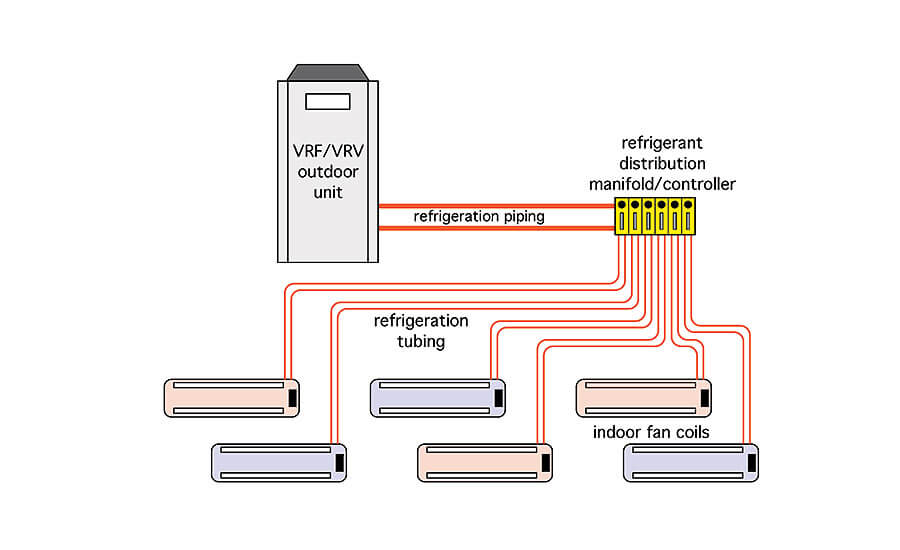VRV is known as Variable Refrigerant Volume system, VWV is known as Variable Water Volume system, and VAV is known as Variable Air Volume system. They are all a form of air conditioning system, and it is easy to understand them when they are strung together according to the air conditioning process.
| Abbreviation | Full Name |
| VRV | Variable Refrigerant Volume system |
| VWV | Variable Water Volume system |
| VAV | Variable Air Volume system |
The three processes of air conditioning cooling and heating, preparing heat and cold in the air conditioning host, transporting heat and cold through the pipes, and transferring heat and cold to the room at the end.
The cooling and heating process of the main unit of air conditioner is the circulation of refrigerant in the “four major components”, of which there are two heat exchangers. One is the evaporator, in which the refrigerant absorbs heat and vaporizes and needs to take heat from the outside, which is essentially cooling to the outside; the other is the condenser, in which the refrigerant liquefies and exerts heat and needs to exhaust heat to the outside, which is essentially heating to the outside.

In actual application, one of the heat exchangers of the air conditioner host faces the user side, and by changing the flow of refrigerant, it is used as an evaporator in summer to take heat from the user side, thus cooling the user; in winter, it is used as a condenser to exhaust heat to the user side, thus heating the user.
If the heat exchanger on the user’s side is placed inside the room, it directly transmits heat and cold to the room, which is equivalent to conveying heat and cold with refrigerant in the pipeline, and this is how split type air conditioners for home use work.
VRV can be understood formally as one or more outdoor units driving multiple indoor units to cool and heat the room directly from the refrigerant system. In order to adapt to the change of indoor load, the flow of refrigerant in the tube needs to be constantly adjusted, and it is called VRV variable refrigerant flow air conditioner.

If the heat exchanger of the air conditioner is not put directly into the room, but first exchange energy to the water, and then through the water to transport energy to the room, this is the “water air conditioner”.
When the load at the indoor end of the water air conditioner changes, one is to keep the water flow constant and change the water temperature to adapt to the end load change, which is a fixed volume system. The other is to keep the water temperature unchanged, change the water flow to adapt to changes in indoor load, when the water flow in the pipeline is changing, it is called VWV variable flow air conditioning. The advantage is that it can save the energy consumption of pump power.
The basic form of air conditioning end is fan coil and air conditioning box. The fan coil drives the heat exchange between the indoor air and the coil by the fan, and the heat in the water is transferred to the room, which is called “all-water system”. The air conditioner box has stronger power and heat exchange capacity, and is still essentially a “large fan coil”, but the air is sent to the destination area through the air ducts after heat exchange, which is essentially to exchange heat and cold through the air, and is called an “all-air system”.
When the indoor load of the all-air system changes, one way is to keep the air volume constant and change the air temperature to accommodate the change in load, which is a CAV fixed air volume system. Another method is to keep the air temperature unchanged, change the air volume to adapt to changes in load, when the air volume of the return air is changing, it is called VAV variable air volume air conditioning. The advantage is that it can save energy consumption of fan power.
Conclusion
To summarize, the VRV variable refrigerant system uses refrigerant directly to cool and heat the room, and the refrigerant is used to transport heat and cold in the ducts, and the refrigerant flow rate is changed to adapt to load changes. In the VAV variable air volume system, air is used in the air conditioning unit for heat exchange with water, and the air ducts are used to transport heat and cold.
Three kinds of air conditioning systems, VRV corresponds to the air conditioning process of heat and cold preparation, VWV corresponds to the air conditioning process of heat and cold delivery, VAV corresponds to the end of the heat and cold transfer method. This way their name will be easy to understand.

Muito obrigado pela vossa disponibilidade.
Deus te abençoe 🙏